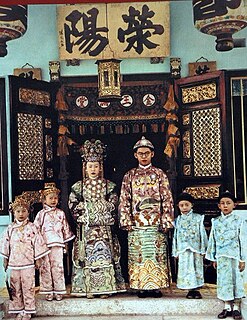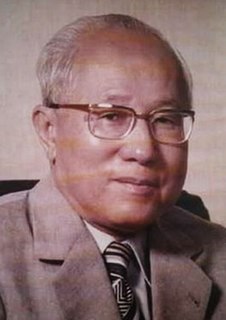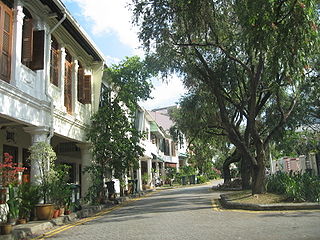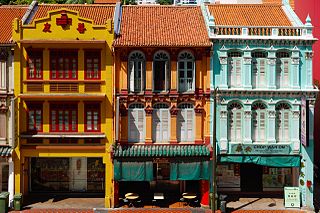
The Peranakans, sometimes referred to as the Straits Chinese or Straits–born Chinese, are an ethnic group defined by their genealogical descent from the first waves of Southern Chinese settlers to maritime Southeast Asia, known as Nanyang, namely the British Colonial ruled ports in the Malay Peninsula, the Indonesian Archipelago as well as Singapore. Peranakan culture, especially in the dominant Peranakan centres of Malacca, Singapore, Penang and Medan, is characterized by its unique hybridization of ancient Chinese culture with the local cultures of the Nusantara region, the result of a centuries-long history of transculturation and interracial marriage.
The Chitty, also known as the Chetty or Chetti Melaka, are a distinctive group of Tamil people found mainly in Melaka in Malaysia and Singapore, who are also known as the "Indian Peranakans" and have adopted Malay (mostly) and Chinese cultural practices whilst also retaining their Hindu faith and heritage. In the 21st century, their population stands at 2,000. The Chitty/Chetti community or Chettiar community, is from South India and are devout Hindus.

Tun Dato' Sir Tan Cheng Lock was a Malaysian Peranakan businessman and a key public figure who devoted his life to fighting for the rights and the social welfare of the Chinese community in Malaya. Tan was also the founder and the first president of the Malayan Chinese Association (MCA), which advocated his cause for the Malayan Chinese population.

Tun Tan Siew Sin was a Malaysian politician who served as the Minister of Commerce and Industry, Minister of Finance, and 3rd President of the Malaysian Chinese Association, a major component party of Alliance and later Barisan Nasional (BN) coalitions. In his term as the Minister of Finance, a new Malaysian currency, Malaysian Ringgit was introduced. He is the longest-serving Minister of Finance by serving in the position for 15 years.

Tan Si Chong Su, or Ancestral Hall of the Tan Clan, is a Chinese temple in Singapore. It is located on Magazine Road in the Singapore River Planning Area within Singapore's central business district. It was constructed between 1876 and 1878 as the ancestral temple for those with the same Tan surname, based on the premise that Chinese people with the same surname would share a common ancestry and therefore belong to the same clan. The Temple also dedicated to Kai Zhang Sheng Wang (開漳聖王),the Patron Deity and founder of Zhangzhou City in China.
Tan Kim Seng, was a prominent Peranakan merchant and philanthropist in Singapore in the 18th century.

Emerald Hill is a neighbourhood and a conservation area located in the planning areas of Newton and Orchard in Singapore. Former home to many members of the city-state's wealthy Peranakan community, it is located near Orchard Road. Many of its homes feature Chinese Baroque architecture. Emerald Hill also the setting for some of the short stories by the late Singaporean author Goh Sin Tub. Many of the homes were designed by Mr R T Rajoo an architect/contractor of those days who died in 1929 at his home in Tank Road, Singapore.

Keong Saik Road is a one-way road located in Chinatown within the Outram Planning Area in Singapore. The road links New Bridge Road to Neil Road, and is intersected by Kreta Ayer Road.
Gan Eng Seng was a Chinese businessman and philanthropist who was one of the early pioneers of Singapore. He is known for his generosity to many charitable causes in Malaya and Singapore during the British colonial era. Some of his most recognised contributions were the setting up of Gan Eng Seng School, the Thong Chai Medical Institution, Tan Tock Seng Hospital, and the Ee Hoe Hean Club.

Baba Nyonya House Museum, also known as the Baba Nyonya Heritage Museum, is a museum in Malacca City, Malacca, Malaysia that showcases the local history of ethnic Chinese-Malays called Baba-Nyonya or Peranakan in the state. The museum was established in 1986 by Chan Kim Lay, the fourth generation of his family to reside in the large house built by his great-grandfather in 1896 in Jalan Tun Tan Cheng Lock, a street also known as "Millionaire's Row" for its luxurious houses. The museum is known for its elaborate woodwork, furniture, and porcelain.

The Peranakan Museum is a museum and gallery in the Museum district of Singapore that specialises in the country's Peranakan culture. It is the sister museum of the Asian Civilisations Museum.

Malacca is a state in Malaysia located in the southern region of the Malay Peninsula, next to the Strait of Malacca. Its capital is Malacca City, dubbed the Historic City, which has been listed as a UNESCO World Heritage Site since 7 July 2008.
The NUS Museum is the oldest university museum in Singapore. It is located within the main campus of the National University of Singapore in southwest Singapore at Kent Ridge. The collections include Chinese, Indian and Southeast Asian materials, consisting of traditional sculptures and paintings, bronzes, jades, ceramics, textiles, and modern and contemporary art. Since 2006, Ahmad Mashadi has been the head of the museum.

Kampung Cina, is a Chinatown located in Kuala Terengganu, Terengganu, Malaysia. Kampung Cina is located along Jalan Bandar, in Kuala Terengganu city centre at the river mouth of Terengganu River that empties into the South China Sea. Kampung Cina literally means Chinese Village; it is also called Teng Lang Po or KT's Chinatown by local people. It is one of Southeast Asia's early Chinese settlements and contains stately ancestral homes, temples, townhouses, and business establishments. The town is small but has colourful shophouses along both sides of the road that carries traditional flavour.

Sino-Portuguese architecture, also known as Chinese Baroque,Straits eclectic architecture or Peranakan architecture is an Asian hybrid style incorporating Chinese and Portuguese architectural styles. It is common in urban centers where Chinese settlers lived in southern China and the Peranakans of the Malay Peninsula, with examples found across present day Peninsular Malaysia, southern Thailand, Singapore, Macau, Vietnam and Hainan.

The Pinang Peranakan Mansion in George Town, Penang, Malaysia, is a museum dedicated to Penang's Peranakan heritage. The museum itself is housed within a distinctive green-hued mansion at Church Street, George Town, which once served as the residence and office of a 19th-century Chinese tycoon, Chung Keng Quee.
Chua Jim Neo, was a Singaporean chef and cookbook writer best known for Mrs. Lee's Cookbook, which preserves the recipes of Peranakan cuisine. Chua was also the mother of Lee Kuan Yew, the first Prime Minister of Singapore.

Peranakan Place, formerly known as Peranakan Corner, is a row of six two-storey shophouses facing Orchard Road, built around 1902 at the intersection of Emerald Hill Road and Orchard Road in the planning area of Newton in Singapore. It forms part of the Emerald Hill Conservation Area within the Orchard district in central Singapore.














